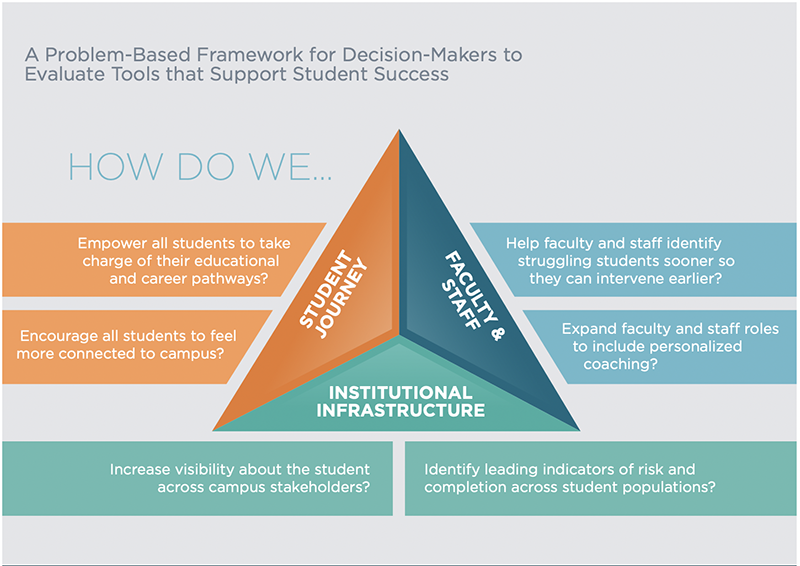Higher education institutions have one overarching goal: student success. That’s what every institutional decision should drive towards and support. But when it comes to the daily grind, it can be easy to lose focus on that high level mission. When you’re trying to solve a problem or pain point, it’s easy to get hyper focused on that specific issue, forgetting to make sure the solution serves a bigger purpose. This means many departments make decisions — especially solution purchasing decisions — that address an acute need but fail to actually help drive student success.
This can be particularly prevalent when introducing new technology. We all love a shiny new solution, but you need to always ask yourself (or those pushing for the solution), “How will this help students better succeed?” Be careful of jumping to conclusions. Streamlining and modernizing a process may seem like it will drive success, but that might not always be the case when put into practice.
When making ed tech purchasing decisions with student success in mind, there’s a few good habits to get into.
Don’t Make Decisions in a Silo
One of the biggest issues with ed tech is the habit of making solution decisions in a silo. There are so many departments at an institution that it’s not uncommon for them to act independently to solve their own challenges. This can result in several departments having very similar solutions. Not only is this a bad budget and IT maintenance decision, it can also drive students to stop using some (or all) of the platforms provided.
The 2021 Connected Student Report from Salesforce found that 26% of students report needing to sign into two or more platforms daily. Having too many platforms not only makes getting anything done difficult, but it can often lead to students simply disengaging because they are frustrated or overwhelmed. Or students will pick their preferred platform and only use that one, meaning your student population is split among solutions. Multiple platforms and disjointed systems also put an institution at major risk of over communication. While communicating is a good thing, drowning students in emails from different platforms and departments is a surefire way to ensure they stop checking email and miss vital messages.
When student success is the ultimate goal, institutions need to be intentional about the solutions and platforms they expect students to use. To achieve this goal, decisions can’t be made in a silo. The department might be largely self contained, but the students aren’t.
Seek Student Opinions
Don’t make decisions in an administrative bubble. Staff, faculty and administrators may be the ones who are trying to solve a particular problem, but when making purchasing decisions with an eye toward student success you need to make sure that “problem” is actually a problem for students. There will certainly be issues that need to be addressed even if they don’t have a direct impact on student success, but overall keep students front and center.
This means getting student opinions. Whether via focus groups, student surveys or simply talking to student employees about their experiences, giving the student voice a seat at the table should be a cornerstone of the tech evaluation process. Even if you get multiple administrative opinions, no opinions matter more than your base customer: the student.
When considering the student opinion, ask:
- Do students want this technology or solution?
- Does it actually meet student needs and expectations?
- Is it solving for a pain point students care about or feel impedes their success?
- Does this provide a markedly improved experience in their eyes?
Interested in student expectations and experiences? Request your copy of the Fall 2021 Pathify Mag: The Student Experience Issue
Remember the Problem-Based Framework for Ed Tech Evaluation
EdSurge put out a report entirely dedicated to vetting tools that support student success. They found that choosing technology that enables student success comes down to three fundamental factors:
1. Improving the student journey
2. Empowering faculty and staff to better support students
3. Creating an institutional infrastructure to enable data-driven decisions
They also created a chart with some sample questions for each category. All these questions are fundamentally student-focused. Even the infrastructure and data-based decision questions center around having data and insights that can ultimately help students succeed.

Getting into the habit of keeping the student at the center of everything can help IT teams guide tech requests and solution evaluations to ensure smart decisions that will have a real impact.
